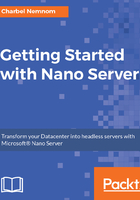
Installing agents and tools
Microsoft does not support MSI in Nano Server. There is a reason for this. Firstly, MSI is built primarily for local installation, so remote installation can be problematic. Secondly, when you uninstall software that was installed using MSI, there is never a guarantee that everything will be cleaned up after the process is completed. A complete uninstall means all the registry entries they have and all the files that we ever put on disk should have been cleaned up. This has never been a guarantee with MSI in the past. Thirdly, MSI is being used to create custom scripts. In other words, people who use the feature to merely write scripts and deploy them to their system make things even worse when they come back and uninstall things afterward. All of this jeopardizes the reliability and stability of the system. With these drawbacks and the fact that MSI relies on a large chunk of .NET Framework which is not supported on Nano Server, Microsoft made the conscious decision to not include MSI support in Nano Server. Instead, they created a new installer based on xFormat. It is the format used by the Windows Store for all Windows Store apps, whether modern or legacy, and the Windows Server App (WSA) installer, which is not just for Nano Server but for all Windows Server 2016. WSA is important as it is the officially supported Server Installer going forward and is the only installer available on Nano Server. WSA promises a complete and clean uninstall and never leaves the system in an unreliable or unstable state.
With WSA, you can package apps so that you have a declarative, intent-based installer.
Examples of the tools and agents that can be installed using the new xFormat installer include System Center Virtual Machine Manager, System Center Operations Manager, and System Center Configuration Manager. These agents, whether they're Microsoft or non-Microsoft, and all the ISV vendors who are writing antivirus software, database software and so on, will use the new installer to install their tools and apps on it. Since it's a headless environment, the tool could be fully remoteable, in which case you can use everything you want either through PowerShell remoting or through a GUI outside, but it will run against the Nano Server as a server.